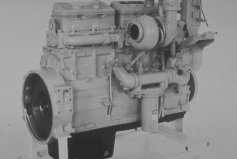
Years of diesel experience have provided Caterpillar with the technology necessary to design and build high quality engines that offer maximum performance at a low overall cost. The specific design considerations for the 3406B include:
- Reliability
- Serviceability
- Long Life before Overhaul is Needed
- Low Overhaul costs
- Application Flexibility
- Fuel Economy
- Oil Control
- Performance
Caterpillar has always emphasized strength and quality, and continues to do so with the 3406B. The 3406B is a heavy-duty, in line, 6- cylinder, diesel engine. The engine has a 5.4 inch bore, 6.5 inch stroke and a displacement of 893 cu. in.
The major engine components will now be discussed in detail.

Cylinder Block
One of the major components in a diesel engine that must exhibit maximum strength is the cylinder block. To provide maximum strength, the block is precision cast using a combination of alloys.
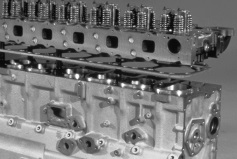
Cylinder Head
The cylinder head is designed to have excellent structural strength and ridgidity. The cylinder head has passed rigorous, deep thermal cycle shock testing for assured durability. This results in a cylinder head with significant resistance to cracking.
The steel or aluminum spacer plate that is used between the cylinder head and the block eliminates the need for deep counterbores in the cylinder block. Deep counterbores decrease the structural integrity of the block and are prone to cracking.
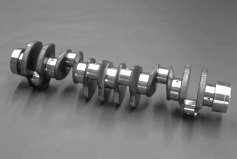
3406B Crankshaft
The crankshaft is a carbon steel forging that is total hardened. Many other diesel engine manufacturers induction harden their crankshafts only at the journals and fillets. This process can leave a stress riser at the boundary between the hardened and unhardened areas. The patented Caterpillar total-hardening process hardens the entire surface of the crankshaft, creating a longer wearing and stronger crankshaft. With the entire surface of the crankshaft hardened, the possibility of cracking is reduced.
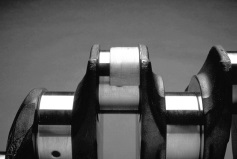
3406C Crankshaft
With the introduction of the 3406C, the size of the rod bearing has been significantly increased (projected area by 19%). The wider bearing spreads the load over a greater surface area, dramatically decreasing the bearing load while increasing the bearing life. This photo shows a former rod bearing on the new crankshaft to demonstrate the increase in bearing area. Additionally, this change increases the oil film thickness by 50% and gives the 3406C the largest rod bearing capacity in its class, eliminating mid-life bearing roll-ins.
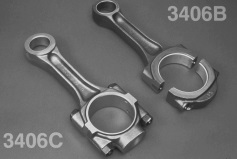
Connecting Rods
The forged boron steel connecting rod is hardened and shot peened for stress relief. The tapered-end design provides additional pin to bore contact area during the power stroke. This results in extra strength and durability of the piston and rod assembly.
New with the 3406C is a larger, stronger connecting rod with a much larger rod bearing. In fact, the wider 3406C rod bearing has the greatest load carrying capacity of any heavy duty engine in its class. By spreading the firing loads over a larger surface area, load carrying capacity, bearing reliability, and service life are all dramatically increased for all ratings.
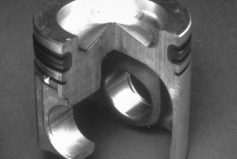
Pistons
Pistons are critical to the design, life, and overall performance of an engine. The Caterpillar 3406B Engine’s three-ring piston is an aluminum alloy casting with a cast-in nickel iron band for the compression rings. The nickel iron band provides improved groove strength and resists wear.
The three-ring piston design provides excellent compression and oil control while reducing friction and heat buildup. This results in extended piston, ring and liner life and reduces maintenance cost at overhaul time.
The piston rings are nodular iron for strength and durability. The oil and intermediate rings are chrome coated, while the top ring is plasma coated. Both coatings provide excellent wear and scuff- resistant properties.
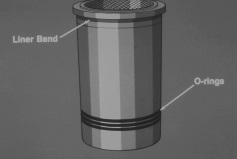
Cylinder Liners
Cylinder liners are made of a cast molybdenum alloy iron for an extra margin of hardness. The internal surface of each liner is induction hardened, then ground in a cross-hatched pattern to aid in oil control. O-rings are used to seal the liner to block coolant cavity. A liner band is used to seal the top of the liner. Because the engine is rigid, these seals remain seated and provide excellent liner sealing.

Valves
Exhaust and intake valves in the 3406B Engine are extremely wear resistant for long life. Three materials are used in the exhaust valves. The stems are made of a hardened stainless steel. A special alloy is used for the heads to provide high temperature strength. The seating faces of the valve are made of Stellite for high temperature wear resistance. Intake valve heads and stems are made from stainless steel and are hardened for resistance to wear.

Valve Seat Inserts
When the valve seats become worn or damaged, valve seat inserts are replaceable. Intake inserts are a stainless steel alloy and the exhaust inserts are a nickel base alloy.
Each valve has a rotator which moves the valve face 3° relative to the valve seat during one complete cycle of the engine. This assures uniform wear for longer valve life and helps prevent burned valves.
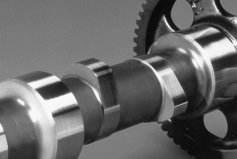
Camshaft
The camshaft is made of a special alloy steel that is drop forged and hardened for reliability and durability. The camshaft gear is heated and pressed on during installation.
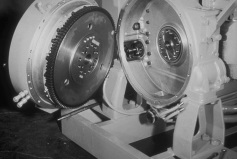
BrakeSaver
The 3406B has an optional BrakeSaver hydraulic retarder that provides smooth, quiet and efficient vehicle braking. The BrakeSaver develops a retarding capability of 360 hp and maintains normal engine temperatures on long downhill grades. The hydraulic operation of the BrakeSaver provides smooth, gradual engagement, reducing the possibility of skids or jackknives.
By relieving the service brakes of the severe wear caused by downhill braking, the BrakeSaver extends brake lining, drum, and tire life.
This reduces user maintenance costs.

Fuel System
The 3406B utilizes a direct injection, scroll type, high pressure fuel system. The system is very efficient, allowing short injection duration and excellent fuel atomization. This results in lower emissions and improved fuel economy.
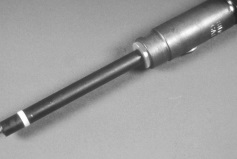
Fuel Injection Nozzle
Injection nozzles can be replaced in the field. The six hole tip atomizes the high pressure fuel flow in the combustion chamber for complete, efficient combustion.
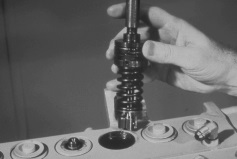
Fuel Injection Pump
Individual scroll-type fuel pumps for each cylinder require no balancing and maintain fuel efficiency without periodic adjustment.
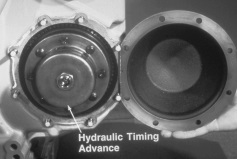
Spring Hydraulic Timing Advance
The speed sensitive timing advance mechanism optimizes performance and makes starting easy. Earlier 3406B Engines used a spring/hydraulic system. As engine speed increases, timing is advanced hydraulically using engine oil. As engine speed decreases, a large spring pushes the timing mechanism toward the retarded position. The spring/hydraulic system has a timing advance capability of 9 degrees.
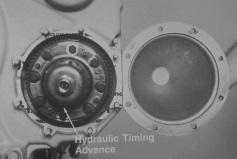
Hydraulic Timing Advance
A double hydraulic automatic timing advance was introduced on the 3406B Engines, serial number 4MG3600 and up. In this system, the timing mechanism advances and retards hydraulically using engine oil. A spool valve actuated by flyweights controls the flow of oil in the timing mechanism. This fully hydraulic system has a timing advance capability of 12 degrees.
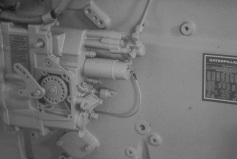
Governor
The Caterpillar 3406B features a full range governor. The hydraulically assisted governor maintains nearly constant speed over rolling terrain similar in effect to automatic speed control in automobiles. This reduces gear shifts and accelerator changes, resulting in improved trip times and less driver fatigue.

Turbocharger
3406B turbochargers are performance matched for each horsepower rating. Their low inertia design reacts rapidly to load demands while delivering full-rated power to the altitude limit appropriate for the application of the engine. This results in improved combustion efficiency and more work per gallon of fuel.